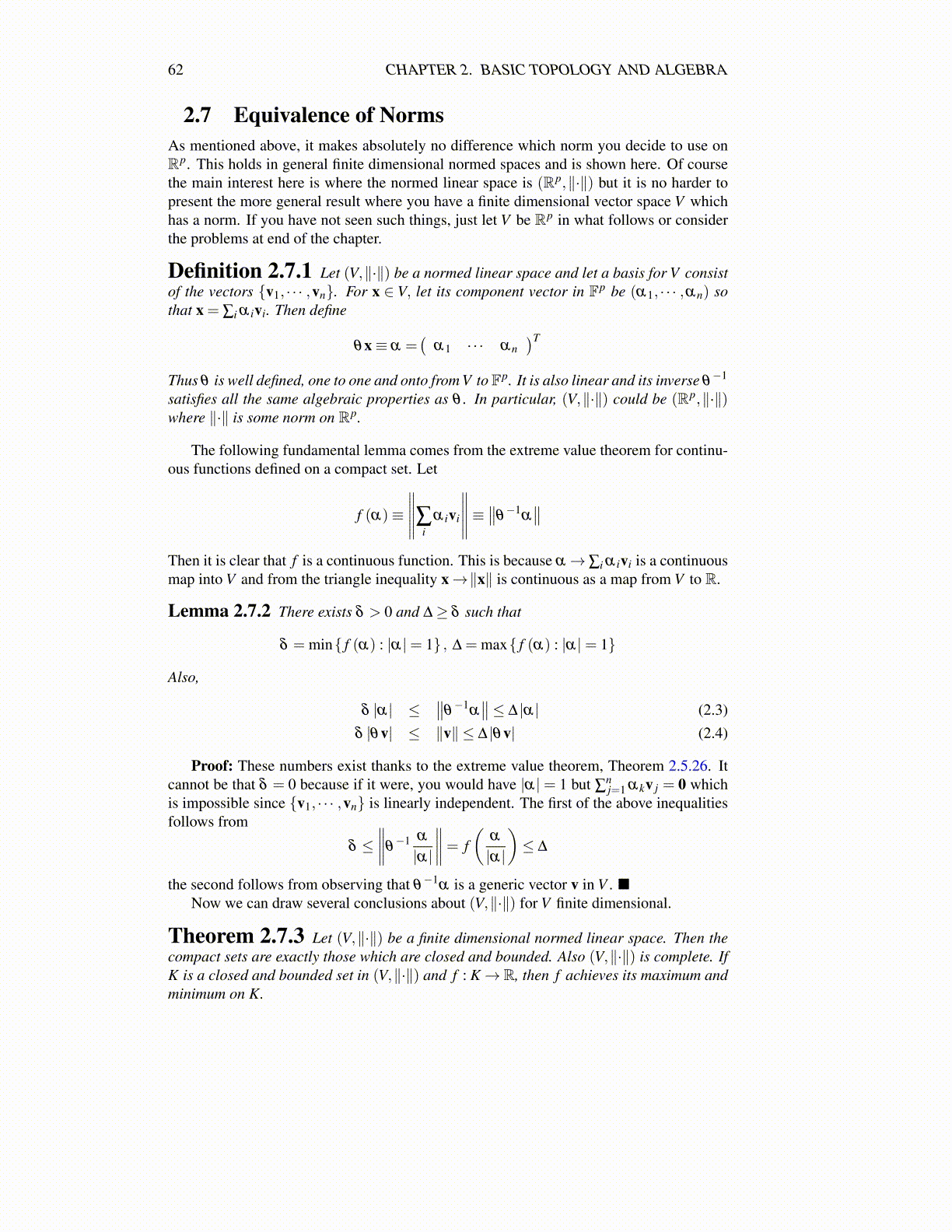
62 CHAPTER 2. BASIC TOPOLOGY AND ALGEBRA
2.7 Equivalence of NormsAs mentioned above, it makes absolutely no difference which norm you decide to use onRp. This holds in general finite dimensional normed spaces and is shown here. Of coursethe main interest here is where the normed linear space is (Rp,∥·∥) but it is no harder topresent the more general result where you have a finite dimensional vector space V whichhas a norm. If you have not seen such things, just let V be Rp in what follows or considerthe problems at end of the chapter.
Definition 2.7.1 Let (V,∥·∥) be a normed linear space and let a basis for V consistof the vectors {v1, · · · ,vn}. For x ∈ V, let its component vector in Fp be (α1, · · · ,αn) sothat x = ∑i α ivi. Then define
θx≡ α =(
α1 · · · αn)T
Thus θ is well defined, one to one and onto from V to Fp. It is also linear and its inverse θ−1
satisfies all the same algebraic properties as θ . In particular, (V,∥·∥) could be (Rp,∥·∥)where ∥·∥ is some norm on Rp.
The following fundamental lemma comes from the extreme value theorem for continu-ous functions defined on a compact set. Let
f (α)≡
∥∥∥∥∥∑iα ivi
∥∥∥∥∥≡ ∥∥θ−1
α∥∥
Then it is clear that f is a continuous function. This is because α→∑i α ivi is a continuousmap into V and from the triangle inequality x→∥x∥ is continuous as a map from V to R.
Lemma 2.7.2 There exists δ > 0 and ∆≥ δ such that
δ = min{ f (α) : |α|= 1} , ∆ = max{ f (α) : |α|= 1}
Also,
δ |α| ≤∥∥θ−1
α∥∥≤ ∆ |α| (2.3)
δ |θv| ≤ ∥v∥ ≤ ∆ |θv| (2.4)
Proof: These numbers exist thanks to the extreme value theorem, Theorem 2.5.26. Itcannot be that δ = 0 because if it were, you would have |α|= 1 but ∑
nj=1 αkv j = 0 which
is impossible since {v1, · · · ,vn} is linearly independent. The first of the above inequalitiesfollows from
δ ≤∥∥∥∥θ−1 α
|α|
∥∥∥∥= f(
α
|α|
)≤ ∆
the second follows from observing that θ−1
α is a generic vector v in V . ■Now we can draw several conclusions about (V,∥·∥) for V finite dimensional.
Theorem 2.7.3 Let (V,∥·∥) be a finite dimensional normed linear space. Then thecompact sets are exactly those which are closed and bounded. Also (V,∥·∥) is complete. IfK is a closed and bounded set in (V,∥·∥) and f : K→R, then f achieves its maximum andminimum on K.